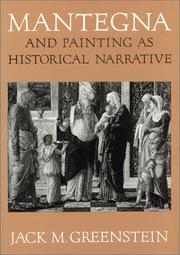| Listing 1 - 3 of 3 |
Sort by
|

ISBN: 0226307077 Year: 1992 Publisher: Chicago London University of Chicago Press
Abstract | Keywords | Export | Availability | Bookmark
 Loading...
Loading...Choose an application
- Reference Manager
- EndNote
- RefWorks (Direct export to RefWorks)
Geschiedenis in de kunst --- Histoire dans l'art --- Historical painting --- Historieschilderkunst --- History in art --- History painting --- Peinture d'histoire --- Jesus Christ --- Mantegna, Andrea, --- Jésus-Christ --- Art --- Criticism and interpretation --- Critique et interprétation --- Jésus-Christ --- Critique et interprétation --- Mantegna, Andrea --- Mantegna, Andrea, 1431-1506 - Criticism and interpretation. --- History in art. --- Jesus Christ - Art. --- Art.
Book
ISBN: 9782754103053 2754103058 Year: 2008 Publisher: Paris : Hazan : Louvre,
Abstract | Keywords | Export | Availability | Bookmark
 Loading...
Loading...Choose an application
- Reference Manager
- EndNote
- RefWorks (Direct export to RefWorks)
Depuis que l'art est l'art, le cœur de l'activité artistique s'est toujours déroulé à part, soit dans le recueillement solitaire nécessaire à la création, soit au contraire dans l'effervescence des grands ateliers européens de la Renaissance et des temps baroques (que l'on songe à Titien et Rubens) ou, plus près de nous, dans l'émulation fraternelle de galetas bohème comme le célèbre Bateau-Lavoir de Picasso, Van Dongen et Gris. Ainsi en va-t-il pour Andrea Mantegna, mis en apprentissage en 1441 dans le meilleur atelier de la ville de Padoue, en Italie : celui de Francesco Squarcione, où il se forme dans le climat humaniste très antiquisant qui caractérise alors cette cité. Après avoir ouvert son premier atelier personnel, ou bottega, en 1448 dans la même ville, il est appelé à Mantoue par les Gonzague où il va se transformer en peintre de cour. Conformément au parti de la collection, cet ouvrage offre une triple approche de l'art de Mantegna à partir de l'atelier comme lieu de travail, comme cadre d'élaboration des thèmes représentés et comme laboratoire des techniques mises en œuvre. Tous les tableaux sont commentés selon cette triple approche. À la cour des Gonzague, Mantegna va pouvoir donner libre cours à de grands programmes allégoriques et décoratifs réalisés à la fresque qui, sous le couvert de la fable, ont pour fonction de glorifier ses maîtres. Une partie des commandes concerne la peinture religieuse qui est étudiée ici dans le rapport du respect de la tradition et des innovations apportées par le maître. Enfin, les principales techniques mises en œuvre, en fonction des programmes : l'huile sur bois, la peinture à fresque, la gravure sur bois ou au burin sont approchées, exemples commentaires d'œuvres à l'appui. (quatrième de couverture)
Artists' studios --- Art, Renaissance --- Painting, Italian --- Artists --- Ateliers d'artistes --- Art de la Renaissance --- Peinture italienne --- Artistes --- Biography. --- Biographies --- Mantegna, Andrea, --- Themes, motives. --- Mantegna, Andrea --- Criticism and interpretation --- 75.033 --- 75.033 Schilderkunst van de Middeleeuwen --- Schilderkunst van de Middeleeuwen --- Mantegna, Andrea, - 1431-1506 - Criticism and interpretation --- Mantegna, Andrea, - 1431-1506
Book
ISBN: 9781912554348 1912554348 Year: 2020 Publisher: London ; Turnhout : Harvey Miller Publishers,
Abstract | Keywords | Export | Availability | Bookmark
 Loading...
Loading...Choose an application
- Reference Manager
- EndNote
- RefWorks (Direct export to RefWorks)
If the fifteenth century in Italy has been seen as the moment when the constellation of disciplines known as ?the humanities? begins to take shape, it was also a time when a ?crisis in the humanities? ? their value, their limits, who and what they included or excluded ? was also manifest. A largely nineteenth century construction of ?Renaissance humanism? has indelibly cast humanist pursuits in terms of writing, with arts of making or techne sometimes idealized as a second order manifestation of humanist ideas. 0This book re-examines the career of one socially and intellectually ambitious artist, Andrea Mantegna (1431-1506) and his intellectual network, to re-open questions of the locations of humanism, the notion of ?humanist art,? or painting as a form of discourse that far from being ancillary to poetry, history, or rhetoric, served as a model for all three. It will be shown that the place of normativity or typicality that Andrea Mantegna occupies in the History of Art ? ?Early Renaissance artist,? ?artist as antiquarian,? ?Albertian perspectivist,? has kept from view the more radical potential of his work for a re-description of early Renaissance painting. The major works examined here ? the Ovetari Chapel, the Camera Picta, the altarpieces for Padua and Verona, the Triumphs of Caesar, adopt strikingly original means to address their beholder, and to control and even produce their spatial and ideological milieu, challenging conventional notions of ?the gaze? and how it operates in early Renaissance art. Furthermore, Mantegna?s representations entail a striking integration of writing and painting as modes of transmission: Mantegna and his audience were highly attentive to the materiality of text, image, and object in the transmission of knowledge.
Mantegna, Andrea --- Mantegna, Andrea, --- Criticism and interpretation --- Art, Early Renaissance. --- Mural painting and decoration, Renaissance --- Painting --- Italy --- History --- Painting, Renaissance --- Art, Early Renaissance --- Humanism --- Influence. --- Humanism in art. --- Peinture de la Renaissance --- Humanisme --- Humanisme de la Renaissance. --- Themes, motives --- Thèmes, motifs. --- Dans l'art. --- Bible --- History of Biblical events --- Art --- Dans l'art --- Themes, motives. --- Art. --- Iconographie biblique --- Mantegna, Andrea, - 1431-1506 - Criticism and interpretation --- Mantegna, Andrea, - 1431-1506
| Listing 1 - 3 of 3 |
Sort by
|

 Search
Search Feedback
Feedback About UniCat
About UniCat  Help
Help News
News